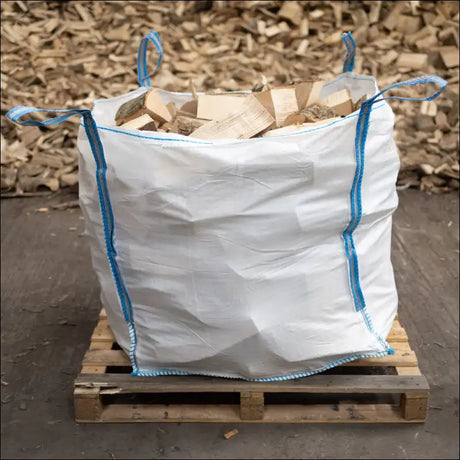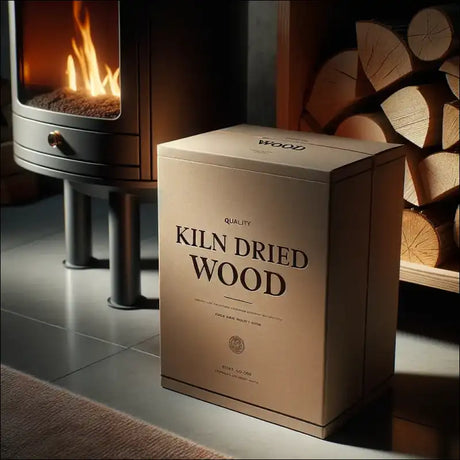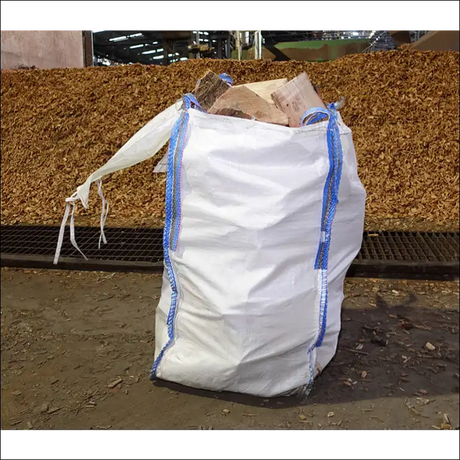Did you know burning wet wood wastes up to 50% heat?
The moisture content of firewood is crucial for log burners or fireplaces. While seasoned wood beats green wood, kiln-dried logs provide superior burning.
Kiln-drying removes moisture, ensuring 9-20% content. This low moisture means efficient combustion, longer burn times, reduced emissions, and easier fire starting than regular firewood. Kiln-dried logs also produce minimal smoke and ash, ideal indoors and outdoors.
Key Takeaways:
- Kiln-dried logs have consistent low moisture for efficient combustion
- Dry firewood advantages: longer burn, reduced emissions, easier starting
- Minimal smoke and ash make kiln-dried logs suitable indoors/outdoors
- Ultra-low moisture saves money, refilling wood burner less often
- Kiln-drying guarantees a superior burning experience over seasoned/green wood
The Importance of Dry Firewood
Firewood's moisture content plays a crucial role. It determines the burn quality and efficiency for log burners, wood stoves, and chimneas. Choosing the right moisture level is essential. Failing to do so leads to reduced heat, increased smoke and particulates, and potential appliance damage.

Moisture Content and Combustion Efficiency
Ideal firewood moisture content is below 20%. When wood contains too much moisture, significant heat evaporates the water instead of warming your home. This results in inefficient burning and reduced heat output.
Properly dried firewood with low moisture allows efficient combustion. You get the most from your fuel.
Green or freshly cut wood has 50%+ moisture content. Burning wet wood is problematic - struggles to ignite, excessive smoke, minimal heat. It also increases chimney fire risk due to condensates and resins.
Reduced Emissions and Cleaner Burning
Using dry firewood contributes to cleaner burning and reduced emissions. As moisture decreases, particulate matter released during burning also diminishes. Wood dried below 20% moisture emits less than half the particulates compared to wet wood.
Kiln-dried firewood ensures consistently low moisture content, typically 10-20%. It guarantees a cleaner burn and minimises environmental impact from heating or cooking. Kiln-dried logs produce less smoke, soot, and creosote buildup - an eco-friendlier choice.
In summary, your firewood's moisture content is critical for efficient, clean, and safe burning with log burners, wood stoves, or chimneas. Invest in properly dried firewood below 20% moisture for improved heat output, reduced emissions, and a pleasant overall experience.
Seasoned Firewood: Pros and Cons
Seasoned wood is popular for fireplaces and fire pits. It undergoes air-drying to lower moisture levels. However, it has advantages and drawbacks.
The Natural Drying Process
Seasoned firewood dries naturally by splitting logs and storing them in well-ventilated areas. The drying time varies:
- Softer woods like ash and pine take 12-18 months.
- Harder woods like ash, oak and apple take 18-24 months.
Inconsistencies in Moisture Levels
A drawback is inconsistent moisture levels. Air-drying reduces moisture to around 25%, higher than ideal.
This inconsistency leads to varying burn qualities and heat output.
Size Requirements for Effective Seasoning
Proper seasoning requires logs cut to 15-20cm diameter and 40cm length. Splitting exposes more surface area for faster drying.
This process is time-consuming but essential for effective seasoning.
Buy seasoned firewood from reputable suppliers following proper practices. Certifications like Woodsure ensure quality and moisture content.
Kiln-Dried Logs: A Superior Alternative

When selecting firewood, kiln-dried logs are a superior choice. The kiln-drying process force-dries wood commercially in 4-6 days. This ensures kiln-dried wood has great benefits.
Consistent Low Moisture Content
Kiln-dried logs have a consistent low moisture content. Green wood is stacked in metal cages in a kiln. Temperatures reaching 70°C drive out moisture through air flow. This rigorous control ensures moisture content below 20%.
The low moisture content provides optimal burning conditions.
Enhanced Burning Performance
The low moisture means kiln-dried logs burn excellently. They light easily and provide high, steady heat output. The consistent quality ensures reliability for fireplaces, stoves, grilling and smoking meat.
Versatility for Indoor and Outdoor Use
Kiln-dried logs suit indoor and outdoor use. Their low moisture means minimal smoke and ash. This reduces blackened stove glass, soot and tarring inside flues.
Outdoors, they provide a reliable, efficient heat source for camping, bonfires and barbecues.
Easier Fire Starting and Maintenance
Kiln-dried logs are easy to use. Their low moisture means they burn immediately upon purchase, needing no seasoning. They are easier to light and tend than regular firewood.
With online suppliers, sourcing this superior alternative is accessible. The consistent quality, enhanced performance and versatility make kiln-dried logs excellent for all indoor and outdoor fire needs.
Why Choose Kiln-Dried Logs Over Regular Firewood?
Kiln-dried logs offer many advantages over regular firewood. Kiln-dried firewood is consistently dry, ensuring efficient combustion and longer burn times. Air-dried logs can have varying moisture levels, but kiln-dried logs burn reliably.
Improved Efficiency and Heat Output
Kiln-dried logs may cost slightly more than seasoned logs, but the benefits outweigh the investment. With under 20% moisture content, kiln-dried wood produces up to 30% more heat per kilogram. This efficiency makes kiln-dried firewood cost-effective long-term, requiring less wood for desired heat.
Cleaner Burning and Reduced Creosote Buildup
Kiln-dried firewood burns cleaner than regular firewood due to low moisture content. It reduces emissions, smoke, and contributes to better indoor and outdoor air quality. Burning kiln-dried logs leads to less creosote buildup, reducing chimney fire risk.
Easier Fire Starting and Maintenance
A significant advantage of kiln-dried logs is their ease of use. Their low moisture content means they light quickly and easily, eliminating frustration associated with starting fires using regular firewood. This convenience is valuable when needing prompt heat.
Additionally, kiln-dried firewood is ready whenever needed. If running low in winter, high-quality kiln-dried logs require no additional treatment or seasoning upon delivery. This peace of mind is invaluable when facing the risk of improperly dried firewood.
Choosing the Right Kiln-Dried Logs for Your Needs

When selecting kiln-dried logs, consider the wood species. Different woods vary in heat output and burning traits.
Hardwoods like ash, oak, and beech offer high heat and long burn times. These keep your home cosy during colder months.
Softwoods, such as pine and spruce, ignite easily. They are better suited for kindling and quick-starting fires.
Check the moisture content is below 20%. This ensures optimal burning performance and minimises creosote buildup in your chimney.
Reputable suppliers provide details on moisture content and wood species. Look for quality assurances like Woodsure certification.
Consider your usage and storage capacity when choosing quantity. Many suppliers offer various package sizes and delivery options.
Choosing the right kiln-dried logs ensures pleasant, efficient burning. It also minimises your environmental impact.





